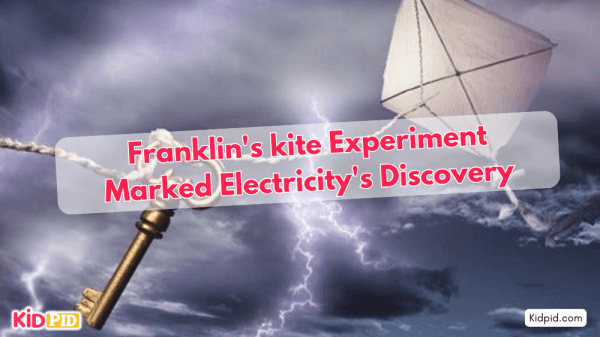Have you ever flown a kite on a windy day? Benjamin Franklin did something special with a kite that helped us understand electricity! Let’s learn about his famous kite experiment and how it changed the world.
- Who Was Benjamin Franklin: Benjamin Franklin was a smart inventor and one of America’s Founding Fathers.
- The Kite Experiment: In 1752, Franklin flew a kite during a thunderstorm to learn about lightning and electricity.
- Discovery of Electricity: Electric charge from the storm traveled down the wet kite string to the key, showing that lightning is a form of electricity.
- Importance of the Experiment: Franklin’s work laid the groundwork for future discoveries in electricity.
The Discovery of Electricity is Attributed to Benjamin Franklin’s Kite Experiment
Related MCQ’S
1. Who is credited with discovering electricity?
A) Thomas Edison
B) Benjamin Franklin
C) Nicola Tesla
D) No one person can be credited
Answer: D) No one person can be credited
Explanation: Electricity was not discovered by one person. Several individuals contributed to its study over centuries, with key figures like Benjamin Franklin and Nikola Tesla playing significant roles.
2. What did Thales of Miletus discover in 500 BC?
A) The electric light bulb
B) The effects of magnetism and static electricity
C) The first electric battery
D) Alternating current (AC) power
Answer: B) The effects of magnetism and static electricity
Explanation: Thales of Miletus discovered the effects of magnetism and static electricity when he rubbed amber with animal fur, causing it to attract objects like feathers.
3. Who invented the first electric battery?
A) William Gilbert
B) Alessandro Volta
C) Thomas Edison
D) Nicola Tesla
Answer: B) Alessandro Volta
Explanation: In 1800, Alessandro Volta invented the voltaic pile, which was the first electric battery that generated a continuous electrical current.
4. Which inventor developed the practical electric light bulb?
A) Nicola Tesla
B) Benjamin Franklin
C) Thomas Edison
D) William Gilbert
Answer: C) Thomas Edison
Explanation: Thomas Edison developed the practical electric light bulb and established the first electric power distribution system.
5. What significant contribution did Nicola Tesla make to electricity?
A) He invented the first electric battery
B) He invented the light bulb
C) He pioneered alternating current (AC) power transmission
D) He discovered magnetism
Answer: C) He pioneered alternating current (AC) power transmission
Explanation: Nicola Tesla revolutionized electricity by pioneering AC power transmission, which had a major impact on how electrical power is generated, transmitted, and distributed.
6. What was discovered in 1936 that suggested the first batteries may have existed over 2,000 years ago?
A) A clay pot with copper plates, tin alloy, and an iron rod
B) A metal key tied to a kite
C) A practical electric light bulb
D) A wire that conducts electricity
Answer: A) A clay pot with copper plates, tin alloy, and an iron rod
Explanation: In 1936, a clay pot was discovered containing materials that suggest the first batteries may have been invented over 2,000 years ago.
You may like these:
Electricity and Circuits
Electricity flows through circuits, powering devices like lights and appliances. Circuits can be series or parallel, allowing electricity to follow specific paths.
Electricity Class 10
Electricity is the flow of electric charge through conductors, generating energy to power devices. It’s fundamental for modern life, powering homes, industries, and technology.
What is Electricity?
Electricity is the movement of charged particles, usually electrons, through a conductor. It powers devices and systems, and exists in two forms: static and current electricity.
